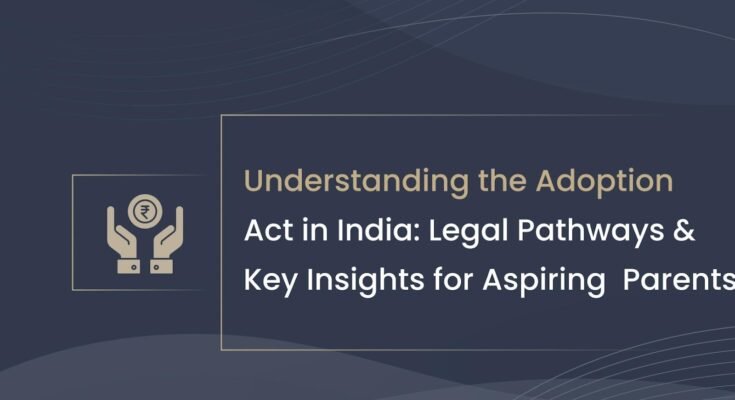Many couples, looking to extend their family, nowadays, go for adoption. It gives the child a life that they might not have expected. In the most populous country, such as India, adoption has now become a norm. However, the process may sometimes pose challenges, and the possibility of exploitation should never be overlooked.
In India, the government has certain laws for adoption which involve the child, birth parents, and adoptive parents. The core among them is the Adoption Act in India, which is managed by the Juvenile Justice (Care and Protection of Children) Act, 2015, and the Central Adoption Resource Authority (CARA). In this article below, we’ll discuss the Adoption Act in India, along with its provisions and step-by-step legal procedure.
Understanding the Historical Background of Adoption Legislation
The adoption practice started in India way before anyone could ever imagine. Even before the 15th century, adoption existed in the country. In ancient Hindu scriptures like the Dharmashastras, the dattaka homa (adoption ritual) was mentioned as a way to continue family lineage and included several religious rites. While the practice was limited to some particular castes, most parents preferred sons.
Even in the British era, there were no laws for adoption. Hindus used to follow the age-old tradition, but Muslims, Christians, and Parsis followed personal laws or the Guardians and Wards Act, 1890, which granted custody but not full parenthood.
Things have changed over the years. In the year 1956, the Hindu Adoption and Maintenance Act (HAMA) came into force, allowing Hindus, Jains, Buddhists, and Sikhs to legally adopt children. Non-Hindus, however, had no such law. To make things uniform, the Adoption Act in India emerged under the Juvenile Justice Act, 2000 (amended 2006, 2015), through CARA, which was established in 1990.
Key Provisions of the Adoption Act in India
The key provisions of the Adoption Act in India are as follows:
- Eligibility: Apart from Indian residents, NRIs and foreigners can also apply. Couples must have a stable marriage lasting a minimum of two years. Single parents are allowed, but a man can never adopt a girl child. Applicants have to be financially secure, emotionally stable, and free from life-threatening illnesses
- Eligible children: Children below 18 years can be adopted but they need to be legally free as orphans and abandoned. Surrendered children can also be adopted after 60-day reconsideration period.
- Secular law: Unlike the previous religion-based rules, the Adoption Act in India applies equally to all Indian citizens, granting full parental rights.
- Mandatory registration: All adoptions must be listed on CARA’s online portal (CARINGS). Private adoption remains illegal in India.
- No commercialization: Any wrongdoing with the children will lead to serious consequences as per Section 370 of the Indian Penal Code and the JJ Act.
Please note: These are significant provisions of the act. For more, you can consult an advocate
Step-by-Step Legal Procedure for Adopting a Child
Here is the step by step procedure mentioned in the Adoption Act in India.
Online Registration: Go to cara.wcd.gov.in and register on CARINGS. Parents need to submit Aadhaar, PAN, photograph, income proof, medical fitness certificate, and marriage certificate (if applicable).
Home Study Report (HSR): After the application is submitted, a social worker conducts 2–3 home visits within 30 days to assess family environment, parenting readiness, and financial stability.
Child Referral: Based on preferences, CARA matches each parent with up to 3 children at a time. They also receive child study reports featuring their medical and social history.
Acceptance & Foster Care: Parents need to accept a referral within 96 hours and take the child in pre-adoption foster care (usually 1 month) for bonding.
Court Application: File a petition in the designated court, along with CARA’s NOC, HSR, and foster care agreement, referring to the District Magistrate.
Final Adoption Order: The court issues the adoption order after verifying all the documents and updates the child’s birth certificate with the new parents’ names.
Post-Adoption Follow-Up: Agencies taking care of the procedure submit progress reports in 1, 6, 12, and 24 months.
Rights and Responsibilities of Adoptive Parents
Here are the Rights of the Adoptive Parents
- Equal inheritance rights: The child is treated as a biological child under the Hindu Succession Act or personal laws.
- Name change & documentation: Parents are allowed to rename the child and have a new birth certificate from the municipal authority.
- Guardianship & decision-making: The new parents will be granted full rights over the child’s education, healthcare, travel, and religion.
Responsibilities of Adoptive Parents include:
- Providing emotional, physical, and financial care.
- Preserving the child’s cultural identity where possible.
- Cooperating with post-adoption monitoring.
- Reporting any major changes (like relocation) to CARA.
Note: The child can only be disowned after extreme conditions and approval from the court.
Challenges & Recent Amendments in Indian Adoption Law
Despite strong laws, there are still several challenges in the Adoption Act in India:
- Low adoption numbers: Only ~4,000 adoptions happen annually against 30,000+ children in need.
- Bureaucratic delays: Lengthy paperwork and court backlogs.
- Social stigma: Preference for infants, as parents seem reluctant to adopt older, disabled, or sibling groups.
- Illegal practices: Some agencies or individuals bypass CARA, leading to trafficking concerns.
Recent amendments in the Adoption Act in India:
- JJ (Amendment) Act, 2021: Empowered District Magistrates to issue adoption orders, which has reduced court delays.
- CARA Regulations, 2022: The new rules have simplified HSR, allowed video conferencing, and prioritized Indian adoptive parents.
- 2023 Guidelines: DMs now look after the entire adoption process in many states, and it has no doubt made the process faster (HSR in 30 days, referral in 15 days).
- Special drives: Incentives for adopting children above 8 years, girls, and siblings.
Conclusions
The recent developments in the Adoption Act in India have transformed the act from a religion-bound custom to a modern, secular law under CARA and the Juvenile Justice Act. The main motto was to ensure every adoption is safe, transparent, and legally backed. This law reflects India’s evolving commitment to child rights and family welfare.




